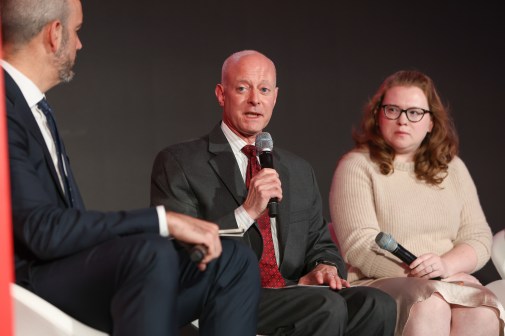Managing risk
 The Defense Department is moving to reduce the number of firewalls it must manage and synchronize. “In the end, if we get this right, we should be able to take about $2 billion out of our current planned operations costs,” said DOD Acting CIO Terry Halvorsen. (Credit: FedScoop)
The Defense Department is moving to reduce the number of firewalls it must manage and synchronize. “In the end, if we get this right, we should be able to take about $2 billion out of our current planned operations costs,” said DOD Acting CIO Terry Halvorsen. (Credit: FedScoop)The Pentagon’s focus on enhancing security goes far beyond the department’s mobility plans. It is also a major component of the new Joint Information Environment — the Defense Department’s overarching concept for how it will consolidate and standardize the design and architecture of its global network.
The first piece of the so-called JIE is an effort to stand up Joint Regional Security Stacks. “It enables us to get to a more coherent and singular security architecture,” Halvorsen said. “But what it really does, coupled with the software we’re going to put with it, it will let all of the services, U.S. Cyber Command, DISA — all of the people who need to see the network — it will let them see the entire picture better.”
There will still be some restrictions on who can act on that data, “but the situational awareness ought to be out there for everybody to see,” he said. “That’s the most powerful piece that will happen as we field the Joint Regional Security Stacks.”
It will also allow the DOD to reduce the number of firewalls that must be synchronized by moving to a central security suite. The department currently manages around 1,600 firewalls, according to Halvorsen. “In the end, if we get this right, we should be able to take about $2 billion out of our current planned operations costs,” he said.
The Pentagon recently completed work on the first JRSS in San Antonio, Texas, and Halvorsen said “things are going very well.” The goal is to have all of the stacks in the U.S. and around the world up and running with new software fielded by the end of 2016 and operational by the first part of 2017, he said.
“That’s ambitious. I’m not going to try to fool anybody,” Halvorsen said. “The hardest part I’m working with right now is how to get the costs within the amount of money that we have.”
Halvorsen just completed a meeting at Fort Huachuca, Arizona, where a team of engineers and budget officials were able to get the initial fielding price down from $490 million to $260 million. Halvorsen expects the price to be driven slightly lower.
https://www.youtube.com/watch?v=fXqqDViaK7A Follow @DanielVerton




